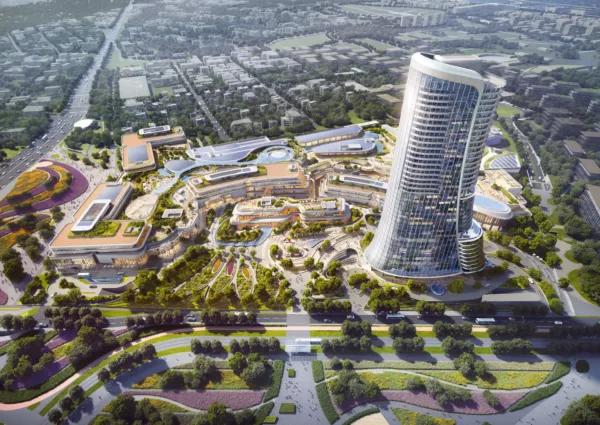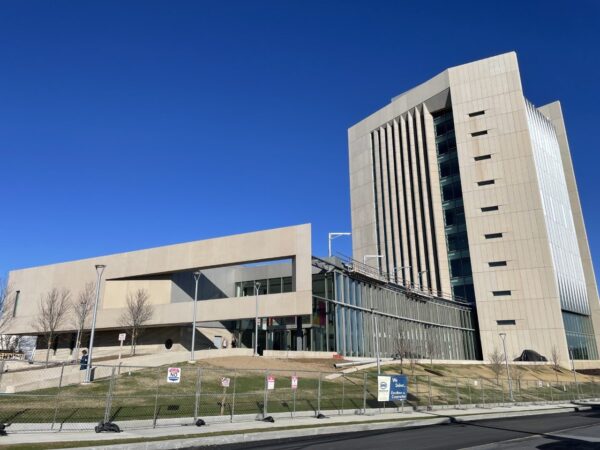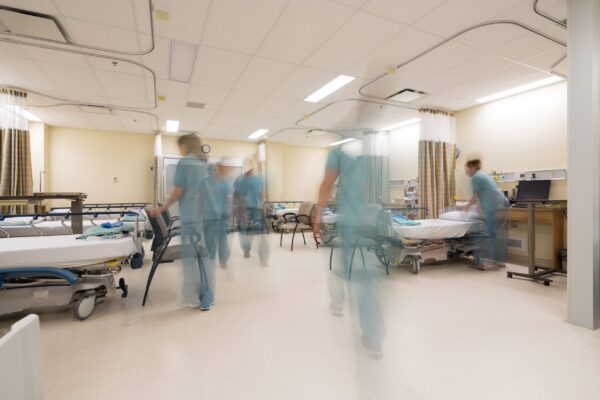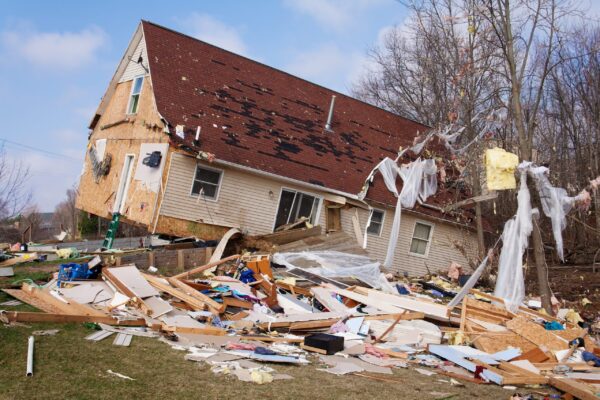

Hill’s new Philadelphia headquarters has received a LEED Silver certification from the U.S. Green Building Council. The prestigious Leadership in Energy and Environmental Design certification was awarded to Hill for its design and construction of office space in two floors at One Commerce Square, a landmark building in the heart of the city’s financial district.
Hill, which moved into the renovated space at 2005 Market Street last spring, managed the design and construction work itself, working with Philadelphia-based architect L2 Partridge to create office space that is both highly aesthetic and highly sustainable, said Lance Rothstein, A.I.A., Vice President in Hill’s Project Management Group. Rothstein was Senior Project Manager of the design, construction and commissioning of the new, 59,497-square-foot space.
“We looked at each and every element of the project, from the earliest stages of design and all through construction and commissioning, to see how we could incorporate as much sustainability and environmental responsibility within the budget as possible,” Rothstein said. “Obtaining a silver certification within budget constraints isn’t easy when working inside a building that is nearly 30 years old,” Rothstein added.
The 41-story, granite-clad building at One Commerce Square was designed by renowned architect I. M. Pei. Completed in 1987, the building was an integral part of the construction boom in western Center City, which boasts Rittenhouse Square, posh retail shops and restaurants, the picturesque Schuylkill River, the Franklin Institute and the iconic Museum of Art. (The building’s adjacent twin, Two Commerce Square, was built later, and completed in 1997.) Capital improvements to the buildings were completed in 2013, and won Commerce Square a LEED Silver certification for sustainability.
LEED provides independent, third-party verification that a building, home or community was designed and built using strategies aimed at achieving high performance in key areas of human and environmental health: sustainable site development, water savings, energy efficiency, materials selection and indoor environmental quality.
Hill had planned to pursue LEED Silver certification for the space since its planning began, Rothstein said.
In addition to being located within a LEED-certified, energy-efficient building, the new headquarters is close to public transportation, including bus, subway and regional rail lines.
“We’re close to bus and rail lines that can take us across the city or across the region,” Rothstein said. In addition, nearby 30th Street Station links passengers with AMTRAK, and the Broad Street Subway system can take passenger to Philadelphia International Airport, enabling passengers to travel even further.
The building’s location in a convenient, “walkable” area also helped. Residences, including single-family homes, townhomes, condominiums and apartments all are within walking distance, as are the shops and other commercial and services businesses that support them. Parks, gyms and other recreation areas also are nearby.
The headquarters is a good neighbor, reducing water and energy usage and waste. Water-saving fixtures installed on both floors netted a 37 percent reduction in water usage, Rothstein said. HVAC, electrical and lighting systems are energy-efficient, as are appliances, he added. “Lights, for example, are motion-activated and light-sensitive, and automatically turn off when not in use or when natural light can do the job,” he explained.
Natural light is abundant in the new space, even on cloudy days. The open, airy feel of the office is accommodated by near-continuous spans of five-foot windows, which flank nearly all of the outside walls. Cubicles are open and airy, with lots of glass to let light—but not much sound—pass through.
The open design on both floors mimics what’s happening throughout the world. “The rise of digital technology has allowed us to do more with less space—less workspace and less space for paper files,” Rothstein said. “The days of heavy, dark wood, large, private offices with solid doors, and everyone having an office are gone.”
Hill also received points for minimizing or recycling its construction waste, and for its participation in building-wide waste minimization and recycling efforts. Notably, most of the existing office furniture was repaired, cleaned up and re-used, saving an estimated $250,000 in furniture purchases. “Using existing furniture also helped Hill in its mission to reduce waste, and office layouts, color schemes and other design and interior design elements were built around the existing furniture, eliminating any guesswork associated with buying new,” Rothstein said.
In addition, the new space meets indoor air quality standards. To help with this, walls and floors were covered with paint, flooring, carpeting and other materials that did not emit high concentrations of harmful chemicals into the air. Low-emitting adhesives and sealants also were used.
Finally, Hill was awarded points for ensuring that each employee at the new headquarters is working in a comfortable environment that’s neither too hot nor too cold, and with ample daylight and pleasing views.
“Our goals were open, modern, and able to accommodate as many people as possible, with room to grow,” Rothstein explained.
Rothstein and his team were thrilled with how the project turned out and the attention it’s received, and equally thrilled to place a sleek LEED Silver plaque at the entrance to the new space.
Michael V. Griffin, P.E., Senior Vice President and Mid-Atlantic Regional Manager, agreed. “We said from the beginning that we wanted a headquarters, based right here in Philadelphia, that would accurately and aesthetically reflect Hill’s standing as a world-class company,” Griffin said. “I am proud of the headquarters’ modern design, its successful combination of form and function, and its inherent sustainability. This certification from the U.S. Green Building Council confirms what we already knew—that we have built a world-class headquarters in a world-class city.”
by Tricia M. McCunney
Share

April 11, 2024 | Articles
A Model Move: Managing Move-In at the Sylvia H. Rambo U.S. Courthouse

April 8, 2024 | Articles

April 4, 2024 | Articles
Driving Growth and Seizing Opportunity: Lukasz Marcinkiewicz Joins Hill as Country Manager, Poland

April 1, 2024 | Articles

March 27, 2024 | Articles
Building the Future: Women’s Leadership and Community Engagement in the Construction Industry

March 25, 2024 | Articles
Leveraging Data Analytics and Dashboards for Enhanced Project Performance

February 26, 2024 | Articles
Continuity, Creativity, and Collaboration: Delivering PennDOT’s Route 18 Signal Upgrade
We and use cookies and other tracking technologies to improve your experience on our website. We may store and/or access information on a device and process personal data, such as your IP address and browsing data, for personalised advertising and content, advertising and content measurement, audience research and services development. Additionally, we may utilize precise geolocation data and identification through device scanning.
Please note that your consent will be valid across all our subdomains. You can change or withdraw your consent at any time by clicking the “Consent Preferences” button at the bottom of your screen. We respect your choices and are committed to providing you with a transparent and secure browsing experience.
| Cookie | Duration | Description |
|---|---|---|
| cookielawinfo-checbox-analytics | 11 months | This cookie is set by GDPR Cookie Consent plugin. The cookie is used to store the user consent for the cookies in the category "Analytics". |
| cookielawinfo-checbox-functional | 11 months | The cookie is set by GDPR cookie consent to record the user consent for the cookies in the category "Functional". |
| cookielawinfo-checbox-others | 11 months | This cookie is set by GDPR Cookie Consent plugin. The cookie is used to store the user consent for the cookies in the category "Other. |
| cookielawinfo-checkbox-necessary | 11 months | This cookie is set by GDPR Cookie Consent plugin. The cookies is used to store the user consent for the cookies in the category "Necessary". |
| cookielawinfo-checkbox-performance | 11 months | This cookie is set by GDPR Cookie Consent plugin. The cookie is used to store the user consent for the cookies in the category "Performance". |
| viewed_cookie_policy | 11 months | The cookie is set by the GDPR Cookie Consent plugin and is used to store whether or not user has consented to the use of cookies. It does not store any personal data. |


